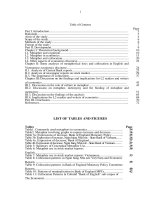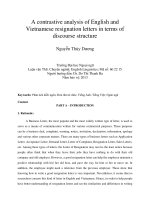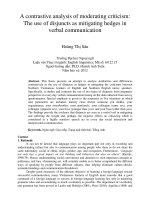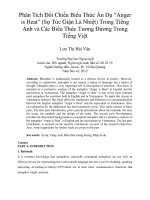A contrastive analysis of moderating criticism The use of disjuncts as mitigating hedges in verbal communication
Bạn đang xem bản rút gọn của tài liệu. Xem và tải ngay bản đầy đủ của tài liệu tại đây (201.65 KB, 6 trang )
A contrastive analysis of moderating criticism:
The use of disjuncts as mitigating hedges in
verbal communication
Hoàng Thị Sáu
Trường Đại học Ngoại ngữ
Luận văn Thạc sĩ ngành: English linguistics; Mã số: 60 22 15
Người hướng dẫn: Ph.D. Huỳnh Anh Tuấn
Năm bảo vệ: 2012
Abstract. This thesis presents an attempt to analyze similarities and differences
contrastively in the use of disjuncts as hedges in mitigating the criticisms between
Northern Vietnamese learners of English and Southern English native speakers.
Specifically, it studies and contrasts the use of two types of disjuncts from pragmatic
perspective in every day verbal communication basing on the data collected from survey
questionnaires. Special emphasis is given to the responses in five situations in which
nine parameters are included, namely close friend, someone you dislike, your
acquaintance, your sister/brother, your aunt/uncle, your colleague (same sex), your
colleague (opposite sex), your boss (younger than you), and your boss (older than you).
The findings provide the evidence that disjuncts are seen as a useful tool in mitigating
and softening the weight and, perhaps, the negative effects on criticizing which is
considered as a highly sensitive speech act in every day social interaction and
interpersonal communication.
Keywords. Ngôn ngữ; Giao tiếp; Trạng ngữ tình thái; Tiếng Anh
Content
1. Rationale
It can not be denied that language plays an important part not only in recording and
understanding culture but also in communication among people who share or do not share the
same nationality, social or ethnic origin, gender, age, and occupation. Furthermore, “language
not only has a great impact on our thinking and behaviors but also on others" (Karmic,
1998:79). Hence, understanding social conventions and attention to such important concepts as
politeness, and face –threatening act, will certainly enable us to better comprehend the different
ways of speaking by people from different cultures, thus helping eliminate culture-shocks,
misunderstandings and communication-breakdown.
Despite good awareness of the ultimate objective of learning a foreign language toward
successful communication, many Vietnamese learners of English must concede that a good
command of a foreign language or success in foreign language learning lies only in mastering
grammar rules and accumulating as much vocabulary as possible. The importance of vocabulary
and grammar has been proved in Laufer and Hulstijn (2001), Putri (2010), Aquilina (1988) and
in many other researches. In spite of different approaches to the matter, these authors state one
thing in common that both vocabulary and grammar are vital aspects in language. However, it
lies in the fact that even when language learners produce grammatically well-formed utterances,
they may experience unwanted culture shock and communication breakdown when running into
a real and particular context of situation. This unexpected incidence occurs due to their
insufficient knowledge and awareness of social norms and values, roles and relationships
between individuals, especially those from the target culture.
Of the universal human speech acts, criticism is considered a high face-threatening act,
and a high- demanding politeness in communication, especially in intercultural communication.
In addition, criticisms are socially complex even for native speakers. Furthermore, many local
and foreign studies regarding the speech act of criticizing have been carried out in different
languages and in interlanguage of English learners of different language backgrounds such as
House and Kasper (1981), Tracy, Van Dusen, and Robison (1987), Tracy and Eisenberg (1990),
Wajnryb (1993; 1995) and Toplak and Katz (2000), Minh (2005), Hoa (2007), and others. The
findings of the previous studies were mainly discussed in the light of cross-cultural perspective.
Yet, hedging in criticizing from pragmatic perspective is still an area available for more
exploration. This research, therefore, has chosen hedging as a potential subject. The study is
done not only to see the similarities and dissimilarities in the use of hedges to criticize between
the two cultures. Another goal of this research is to raise the awareness of both teachers and
learners of English about the necessity of hedging in language, and to give teachers several
suggestions in teaching this language phenomenon to their students.
Nevertheless, hedging is a very broad area, and within the limit of the study, it is
impossible to discuss all aspects of hedging in language. As criticism is an act yielding high risk
of making hearers lose face, it requires different supplementary steps to reduce the weightiness
of the utterance. This is where hedging can mostly be seen. In daily life, no-one likes to be
criticized, and no-one wants to criticize others directly because there still exists the relationship
between people, which is considered most important in every society. Hence, in forced
situations, people still criticize but soften it by using such disjuncts as “frankly, from my point of
view, seriously,…” right before the criticism. That is the reason why the use of disjuncts as
mitigating hedges in criticism is chosen for the project.
Needless to say, disjuncts as hedging devices used in a certain context for specific
communicative intents such as one strategy of politeness and mitigation have great effect on
minimizing shocks in communication. Therefore, a desire to have a further insight into major
similarities and differences in using disjuncts as hedges has inspired the writer to develop the
research entitled “A contrastive analysis of moderating criticism: The use of disjuncts as
mitigating hedges in verbal communication.”
To sum up, it is hoped that this study can provide the increase of some socio-cultural
knowledge and awareness of the importance of hedges before criticizing among both teachers
and learners of English in order to avoid hurting their partners in every day communication. This
also helps enhance better cross-cultural communication and foreign language learning and
teaching in Vietnam.
2. Scope of the study
- The study is confined to the verbal aspects of the act of criticism with the use of politeness and
hedging. In addition, adjacency pairs are beyond the scope of this paper.
- The study strictly pertains to the perspective of pragmatics though the author realizes that
syntactic theory and semantics apparently do explain the meaning of the verbal work
- Northern Vietnamese learners of English and Southern English native speakers are chosen for
contrastive analysis.
- The data are collected by conducting survey questionnaires to examine the ways the Northern
Vietnamese and Southern English native speakers use disjuncts as mitigating hedges. (30
informants each)
- Hedges under investigation are limited to a single utterance.
3. Aims of the study
- To find out the similarities and differences in the way the Northern Vietnamese learners of
English and Southern English native speakers criticize using disjuncts as a politeness strategy in
mitigating criticism.
- To raise both teacher’s and learner’s awareness of the importance of hedges before criticizing
in order to avoid hurting their partners.
4. Objectives of the study
In order to achieve the targeted aims, two objectives are put forward:
- The data will be collected by conducting survey questionnaires for the chosen informants in
Northern Vietnam and in Southern England. (Hedges under investigation are limited to a single
utterance).
- The data will be processed and analyzed quantitatively to see how the two groups use disjuncts
as hedges in criticizing situations and to see if there are any distinct features that characterize the
way Northern Vietnamese learners use hedges as compared to that of Southern native speakers,
through which implications will be drawn out.
5. Research questions
What are the major similarities and differences in the ways Northern Vietnamese learners
of English and Southern English native speakers use disjuncts as hedges in mitigating criticism?
6. Methodology
- Quantitative method in the form of survey questionnaires is much resorted to. To collect data
for analysis, Metapragmatic Questionnaire (MPQ) is designed. The collected data will be
analyzed using comparing and contrasting techniques to find out the similarities and differences
in the ways Northern Vietnamese learners of English and Southern English native speakers
perform the act of criticizing using hedges as a politeness strategy.
- The questionnaires are delivered directly to 30 Northern Vietnamese learners of English and to
30 English people via e-mails. Based on both Vietnamese and English informants’ status
parameters, the researcher looks for the Vietnamese subjects of similar parameters in order to
have a symmetrical distribution of informants and data for the study.
7. Design of the study
The study is composed of three parts:
Part I: Introduction: presents the rationale, scope, aims, research question, and methodology of
the study
Part II: Development: This part consists of four chapters:
Chapter 1: Theoretical background and Literature review :
- Theoretical background: discusses the notions of speech act theory, face, politeness, politeness
strategies, hedges and disjuncts.
Chapter 2:: Hedging before criticizing: This chapter explores previous works of criticizing,
hedging, hedging strategies and disjuncts from pragmatic perspective.
Chapter 3: Methodology: This chapter states the chosen methods to carry out the study and to
analyze the collected data such as contrastive analysis (CA), and survey questionnaires. It also
deals with informants and procedures of the data collection.
Chapter 4: Data analysis and findings: This chapter analyses collected data to find out major
similarities and differences in the choice of hedging strategies in given situations by Vietnamese
learners of English and native speakers of English.
Part III: Conclusion: This part summarizes the main findings of the study, provides some
implications for TEFL, and offers suggestions for further research.
References
A.IN ENGLISH:
1. Aquilina, P. J. (1988). The Role of Grammar in the Second Language
Classroom. July 25, 1988.
2. Austin, J. L. (1962). How to Do Things with Words. Oxford: OUP
3. Bach, R., and Harnish, R. M. (1979). Linguistic Communication and Speech Acts. Cambridge:
The MIT Press.
4. Blum-Kulka, S. (1987). Indirectness and politeness in requests: Same or different? Journal of
Pragmatics 11, 131-146.
5. Blum-Kulka, S., House, J., & Kasper, G. (Eds). (1989). Cross-cultural Pragmatics: Requests
and Apologies. (Vol. XXXI) Norwood, New Jersey: Ablex.
6. Brown, G. and Yule, G. (1983). Discourse Analysis. Cambridge: CUP.
7. Brown, P., & Levinson, S. (1978). Universals in language usage: Politeness phenomena. In E.
Goody (Ed). Questions and Politeness: Strategies in Social Interaction. Cambridge: CUP.
8. Brown, P., & Levinson, S. (1987). Politeness: Some Universals in Language Usage.
Cambridge: CUP.
9. Channel, J. (1994). Vague Language. UK: OUP.
10. Dascal, M. (1983). Pragmatics and the Philosophy of Mind - Volume 1: Thought in
Language. Amsterdam: John Benjamins.
11. Eelen, G. (2001). A Critique of Politeness Theory. Manchester: St. Jerome’s Press.
12. Hulstijn, J.H.& Laufer, B. (2001). Some imperical evidence for involvement load hypothesis
in vocabulary acquisition. Language learning, 51, 3, (539 – 558).
13. Grice, P. (1975). Logic and conversation. In P. Cole & J. Morgan (Eds), Speech Acts. New
York: Academic Press.
14. Heng, S.C., & Tan, H. (2002). Maybe, perhaps, I believe, You could – Making claims and the
use of hedges. University Putra Malaysia.
15. Hinkel, E. (1997). Culture in second language teaching and learning. Cambridge:
Cambridge University Press
16. Hoa, H. (2007). Criticizing behaviors by the Vietnamese and the American: topics, social
factors and frequency. College of Foreign Languages, Vietnam National University, Hanoi,
17. Holmes, J. (1992). An Introduction to Sociolinguistics. London: Longman.
18. Holmes, J. (1995). Women, Men and Politeness. London: Longman.
19. House, J., & Kasper, G. (1981). Politeness markers in English and German. In F.
20. Hubler, A. (1983). Understatements and Hedges in English. Amsterdam/ Philadelphia: John
Benjamins Publishing Company.
21. Hyland, K. (1998). Hedging in Scientific Research Articles. Amsterdam/ Philadelphia: John
Benjamins Publishing Company.
22. James, C. (1983). Contrastive Analysis. Essex: Longman Group Ltd.
23. Kasper, G. (1992). Pragmatic transfer. Second Language Research 8 (3), 203-231.
24. Kasper, G., & Blum-Kulka, S. (1993). Interlanguage Pragmatics. New York: OUP.
25. Lado, R. (1957). Linguistics across cultures: Applied linguistics for language teachers.
University of Michigan Press: Ann Arbor.
26. Lakoff, G. (1972). Hedges: A study of meaning criteria and the logic of fuzzy concepts.
Chicago: Chicago Linguistics Society.
27. Lakoff, R. (1973). The logic of politeness: Or minding your P’s and Q’s. In C. Corum.
28. Smith-Stark & A. Weiser (Eds.), Papers from the Ninth Regional Meeting of the Chicago
Linguistics Society. Chicago: Chicago Linguistics Society.
29. Leech, G, (1983). Principles of Pragmatics. New York: Longman.
30. Levinson, S. C. (1983). Pragmatics. Cambridge: CUP.
31. Longman. (1998). Longman Dictionary of English Language and Culture (2nd Edition).
Harlow: Longman.
32. Markkanen, R. and H. Schröder (1985). Introduction. In Markkanen R. and H.
Schröder (eds.) Hedging and Discourse: Approaches to the Analysis of a
Pragmatic Phenomenon in Academic Texts. Berlin: Walter de Gruyter. 1 – 18.
Oxford Learner’s Dictionary, 2002.
33. Minh, N. (2005). Criticizing and Responding to Criticism In A Foreign Language: A study of
Vietnamese Learners of English. PhD Thesis. The University of Auckland.
34. Nikula, T. (1997). Interlanguage View on Hedging. In Markkanen R. and H.
Schröder (eds.) Hedging and Discourse: Approaches to the Analysis of a
Pragmatic Phenomenon in Academic Texts. Berlin: Walter de Gruyter. 188 – 207.
35. Nordquist, R. (2006). Guide to Grammar and Composition. Macmillan: St. Martin's Press).
36. Prince, E., J. Frader and C. Bosk (1982). On hedging in physician-physician discourse. In Di
Pietro R.J. (ed.) Linguistics and the professions. Hillsdale, NJ: Ablex. 83 – 97.
37. Putri, H. F. (2010). The Importance of Vocabulary in English Learning. English and
Education Falculty. Bogor: INB Khaldun University.
38. Quang, N. (2005). Cross-cultural Communication- Lecture Notes-Hanoi.
39. Quirk, R., Greenbaum, S., Leech, G., & Svartvik, J. (1972). A Grammar of Comtemporary
English. London: Longman.
40. Salager-Meyer, F. (1994). Hedges and Textual Communicative Function in Medical English
Written Discourse. English for Specific Purposes Vol 13. 149 – 170.
41. Searle, J. (1974). Speech Acts. Cambridge: CUP.
42. Searle, J. (1979). Indirect Speech Acts. In P. Cole & J. Morgan (Eds), Syntax and semantics.
Vol. 3: Speech Acts. New York: Academic Press.
43. Sinh, N. (2004). A Vietnamese – English Cross Cultural Study on the Use of Hedging in
Dispraising. MA. Thesis. Ha Noi: ULIS.
44. Thomas, J. (1995). Meaning in Interaction: An Introduction to Pragmatics. UK: Longman
45. Thompson, N. (2003). Communication and Language: A Handbook of Theory and Practice.
UK: Palgrave MacMilan.
46. Toplak, M., & Katz, A. (2000). On the uses of sarcastic irony. Journal of Pragmatics 32,
1467-1488.
47. Tracy, K., & Eisenberg, E. (1990). Giving criticisms: a multiple goal case study. Research on
Language and Social Interaction 24, 37-70.
48. Tracy, K., Van Dusen, D., & Robinson, S. (1987). Good and bad criticism: a descriptive
analysis. Journal of Communication 37, 46-59.
49. Wajnryb, R. (1993). Strategies for the management and delivery of criticisms. EA Journal 11
(2), 74-84.
50. Wajnryb, R. (1995). The perception of criticism: one trainee's experience. EA Journal 13 (1),
54-68.
51. Watts, R. J. (2003). Politeness. Cambridge: CUP.
52. Yule, G. (1996). Pragmatics. Oxford: Oxford University Press.
B. IN VIETNAMESE:
1. Nguyễn Đức Dân. (1998). Ngữ dụng học, Tập 1. Giáo dục.
2. Ngô Hữu Hoàng. (2003). Vai trò vủa quán ngữ trong việc kiến tạo phát ngôn. Luận án tiến sĩ
ngữ văn. ĐHKHXHNV – ĐHQGHN.
3. Nguyễn Thiện Giáp. (1976), Từ và nhận diện từ tiếng Việt. Hà Nội: NXB Giáo Dục
4. Nguyễn Quang. (2002), Giao tiếp và giao tiếp giao văn hóa. Hà Nội: NXB ĐHQG Hà Nội.









